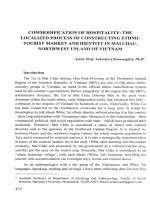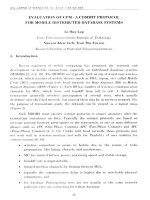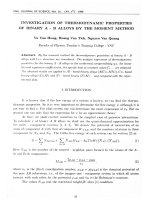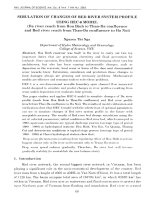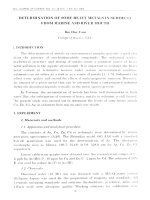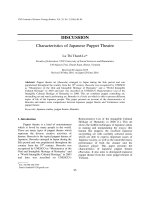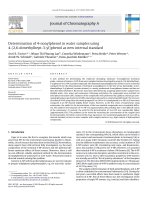DSpace at VNU: Occurrence of Sanqiaspis, Liu, 1975 (Vertebrata, Galeaspida) in the Lower Devonian of Vietnam, with remarks on the anatomy and systematics of the Sanqiaspididae
Bạn đang xem bản rút gọn của tài liệu. Xem và tải ngay bản đầy đủ của tài liệu tại đây (609.07 KB, 7 trang )
Available online at www.sciencedirect.com
C. R. Palevol 8 (2009) 59–65
Systematic Palaeontology (Vertebrate Palaeontology)
Occurrence of Sanqiaspis, Liu, 1975 (Vertebrata, Galeaspida) in the
Lower Devonian of Vietnam, with remarks on the anatomy and
systematics of the Sanqiaspididae
Philippe Janvier a,∗ , Tong-Dzuy Thanh b , Ta Hoa Phuong b ,
Gaël Clément a , Nguyên Duc Phong c
a
UMR 5143, CNRS, CP 38, Muséum national d’histoire naturelle, 47, rue Cuvier, 75231 Paris cedex 05, France
Vietnam National University, Department of Geology, 334 Nguyên Trai Street, Thanh Xuan, Hanoi, Viet Nam
c Institute of Geology and Mineral Resources, Thanh Xuan, Hanoi, Viet Nam
b
Received 6 August 2008; accepted after revision 3 October 2008
Available online 11 December 2008
Presented by Philippe Taquet
Abstract
A new species of the huananaspidiform galeaspid genus Sanqiaspis is reported from the Lochkovian Si Ka Formation of northern
Vietnam and is somewhat older than the previously recorded occurrences of this genus, from the Pragian Posongchong Formation
of southern China. This species provides new information about the anatomy of the head shield in the Sanqiaspididae and notably
provides evidence of a complete endoskeletal and dermal postbranchial wall, like in osteostracans. The various types of vertebrate
assemblages defined in the Lower Devonian of China are discussed, by comparison to the vertebrate faunas hitherto recorded from
the Lower Devonian of Vietnam, and it is suggested that their composition is strongly influenced by environmental factors. To cite
this article: P. Janvier et al., C. R. Palevol 8 (2009).
© 2008 Académie des sciences. Published by Elsevier Masson SAS. All rights reserved.
Résumé
Présence de Sanqiaspis, Liu, 1975 (Vertebrata, Galeaspida) dans le Dévonien inférieur du Viêt Nam, avec des remarques
sur l’anatomie et la systématique des Sanqiaspididae. Une nouvelle espèce du genre de galéaspide huananaspidiforme Sanqiaspis,
est décrite dans la Formation de Si Ka du Lochkovien du nord du Viêt Nam et apparaît plus ancienne que les représentants de ce genre
décrits jusqu’alors dans la formation praguienne de Posongchong de Chine du Sud. Cette espèce apporte de nouvelles informations
sur l’anatomie du bouclier céphalique des Sanqiaspididae et montre la présence d’une cloison postbranchiale endosquelettique et
dermique complète, comme chez les ostéostracés. Les divers types d’assemblages de vertébrés définis dans le Dévonien inférieur
de Chine sont brièvement comparés aux faunes de vertébrés reconnues dans le Dévonien inférieur du Viêt Nam et il est suggéré que
leur composition est fortement influencée par des facteurs environnementaux. Pour citer cet article : P. Janvier et al., C. R. Palevol
8 (2009).
© 2008 Académie des sciences. Publi´e par Elsevier Masson SAS. Tous droits réservés.
Keywords: Vertebrata; Galeaspida; Anatomy; Systematics; Devonian; Palaeobiogeography; Vietnam; China
Mots clés : Vertebrata ; Galeaspida ; Anatomie ; Systématique ; Dévonien ; Paléobiogéographie ; Viêt Nam ; Chine
∗
Corresponding author.
E-mail address: (P. Janvier).
1631-0683/$ – see front matter © 2008 Académie des sciences. Published by Elsevier Masson SAS. All rights reserved.
doi:10.1016/j.crpv.2008.10.008
60
P. Janvier et al. / C. R. Palevol 8 (2009) 59–65
1. Introduction
The Galeaspida, or galeaspids, are an extinct clade
of amoured jawless vertebrates which is, to date, exclusively known from the Silurian and Devonian of China
and Vietnam [4,5,8,13,14,19,24,25,36]. They are currently regarded as the sister group of osteostracans, or
“cephalaspids”, and jawed vertebrates, with which they
share a perichondrally calcified, or ossified, braincase
[2,3,5,7,8,31]. The braincase of galeaspids is covered
dorsally by an extensive dermal bone layer of galespidin,
or “head shield”, pierced by widely separated orbits and
a presumably incurrent median dorsal opening. The latter is a unique character of galeaspids, alongside the
����������������������������������������������������������������������������������������������������������������������������������������������������������������������������������������������������������������������������������������������������������������������������������������������������������������������������������������������������������������������������������������������������������������������������������������������������������������������������������������������������������������������������������������������������������������������������������������������������������������������������������������������������������������������������������������������������������������������������������������������������������������������������������������������������������������������������������������������������������������������������������������������������������������������������������������������������������������������������������������������������������������������������������������������������������������������������������������������������������������������������������������������������������������������������������������������������������������������������������������������������������������������������������������������������������������������������������������������������������������������������������������������������������������������������������������������������������������������������������������������������������������������������������������������������������������������������������������������������������������������������������������������������������������������������������������������������������������������������������������������������������������������������������������������������������������������������������������������������������������������������������������������������������������������������������������������������������������������������������������������������������������������������������������������������������������������������������������������������������������������������������������������������������������������������������������������������������������������������������������������������������������������������������������������������������������������������������������������������������������������������������������������������������������������������������������������������������������������������������������������������������������������������������������������������������������������������������������������������������������������������������������������������������������������������������������������������������������������������������������������������������������������������������������������������������������������������������������������������������������������������������������������������������������������������������������������������������������������������������������������������������������������������������������������������������������������������������������������������������������������������������������������������������������������������������������������������������������������������������������������������������������������������������������������������������������������������������������������������������������������������������������������������������������������������������������������������������������������������������������������������������������������������������������������������������������������������������������������������������������������������������������������������������������������������������������������������������������������������������������������������������������������������������������������������������������������������������������������������������������������������������������������������������������������������������������������������������������������������������������������������������������������������������������������������������������������������������������������������������������������������������������������������������������������������������������������������������������������������������������������������������������imen before preparation
of the postbranchial wall (B1), elastomer cast after preparation exposing the postbranchial wall (B2), and explanatory sketch (B3). C. Attempted
graphic restoration of the original proportions of the specimen in dorsal (C1) and ventral (C2) view. Scale bar = 10 mm.
Fig. 2. Sanqiaspis vietnamensis n. sp., Formation de Si Ka, Lochkovien (Dévonien inférieur) de Lung Cu, Nord du Viêt Nam. A. Bouclier céphalique
incomplet (BT 338, holotype) en vue dorsale ; moulage en élastomère (A1) et schéma explicatif (A2). B. Contre-empreinte ventrale du même
spécimen avant préparation de la cloison postbranchiale (B1), moulage en élastomère après préparation de la cloison postbranchiale (B2) et schéma
explicatif (B3). C. Essai de reconstitution graphique des proportions originales du spécimen en vues dorsale (C1) et ventrale (C2). Échelle = 10 mm.
distorted during fossilization (Fig. 2A). Its original shape
and proportions have been restored by using the “skew”
command of Photoshop, and bringing the commissural
sensory line in a transverse position (Fig. 2C).
3. Geological setting
The Lower Devonian of eastern Bac Bo (northeastern
Vietnam) is typically composed of a gradual succession of three formations, the Si Ka, Bac Bun and Mia
Lé formations, the former two being gathered in the
Song Cau Group [27]. The Si Ka Formation generally
consists of reddish sandstone and siltstone, the Bac Bun
Formation of siltstone, marl, shale and dolomite, and the
Mia Lé Formation of marl, shale, sandstone and limestone. This formation series indicates, from base to top, a
progressive installation of a more and more marine environment, in which the fish remains become abundant at
the transition between the Si Ka and Bac Bun formations, along with the first marine invertebrates (notably
the brachiopod Howittia wangi) in the middle part of the
Bac Bun Formation [25–27]. This sequence shows some
local variations, notably the lack of the arenaceous Si Ka
Formation and the predominance of bituminous shale in
62
P. Janvier et al. / C. R. Palevol 8 (2009) 59–65
the Quan Ba area, north of Ha Giang [22,28], and further
west, in the Lai Chau Province.
The specimen described herein comes from the siltstone beds of the middle part of the Si Ka Formation
that crops out along the Ma Lé (Mia Lé)–Lung Co road,
a classical Devonian section which is known since the
early works of Mansuy [18] and Deprat [1,10]. It was
found along with plant remains, large arthropod fragments, gastropods, rare lingulids and abundant remains
of other fish groups. Among the latter are at least two
other galeaspids (probably Polybranchiaspis sp. and
a large indeterminate form), at least three antiarchs
(Heteroyunnanolepis sp., Yunnanolepis cf. Y. spinulosa,
Janvier and Ta Hoa, 1999 [10] and Chuchinolepis sp.),
an indeterminate placoderm (arthrodire or petalichthyid)
and at least one sarcopterygian (probably a Youngolepididae).
4. Systematic study
The specimen displays the overall morphology of the
two galeaspid species currently referred to the genus
Sanqiaspis and characterized by a transversely elongated
median dorsal opening, elongated head shield, posteriorly directed cornual processes, anterior rostral process
and numerous, transversely elongated branchial fossae
(Figs. 2 and 3E–G). However, it differs from all other
described species of the genus Sanqiaspis by its proportions and the shape of its rostral process and is therefore
referred to a new species.
Subclass Galeaspida Halstead, Tarlo, 1967 [23]
Order Huananaspidiformes, Janvier, 1975 [4]
Family Sanqiaspididae, Liu, 1975 [14]
Genus Sanqiaspis, Liu, 1975 [14]
Sanqiaspis vietnamensis n. sp.
(Fig. 2)
Fig. 3. Phylogenetic relationships of the Huananaspidiformes (after
tree topology in Zhu and Gai [36]), with particular reference to the
most inclusive taxa of the clade. A. Antiquisagittaspis. B. Sanchaspis.
C. Gantarostrataspis. D. Wumengshanaspis. E. Sanqiaspis rostrata.
F. Sanqiaspis zhaotongensis. G. Sanqiaspis vietnamensis. H.
Huananaspis and all other Huananaspidiformes. Scale bar = 10 mm.
Head shields in dorsal view, redrawn after [15] (A); [21] (B); [29]
(C); [32] (D); [34] (E); [30] (F); [14] (H).
Fig. 3. Relations phylogénétiques au sein des Huananaspidiformes
(d’après la topologie proposée par Zhu et Gai [36]), en particulier
les formes les plus inclusives de ce clade. A. Antiquisagittaspis.
B. Sanchaspis. C. Gantarostrataspis. D. Wumengshanaspis. E.
Diagnosis: A Sanqiaspis species with short and distally expanded rostral process. The maximum breadth of
the head shield is about thrice that of the median dorsal
opening and the length of the cornual processes is about
half the breadth of the median dorsal opening.
Type specimen: An incomplete and slightly distorted
head shield (Museum of the Geological Survey of Vietnam, Hanoi, BT338) (Fig. 2A, B).
Sanqiaspis rostrata. F. Sanqiaspis zhaotongensis. G. Sanqiaspis vietnamensis. H. Huananaspis et tous les autres Huananaspidiformes.
Échelle = 10 mm. Boucliers céphaliques en vue dorsale, redessinés
d’après [15] (A) ; [21] (B) ; [29] (C) ; [32] (D) ; [34] (E) ; [30] (F) ;
[14] (H).
P. Janvier et al. / C. R. Palevol 8 (2009) 59–65
Type locality: Lung Cu–Ma Lé section, Lung Cu village, Dong Van district, Ha Giang Province, northern
Vietnam.
Age: Lower Devonian (Lochkovian), middle part of
the Si Ka Formation.
Referred material: The holotype only.
Remarks: Sanqiaspis vietnamensis clearly differs
from the type species of the genus Sanqiaspis, Sanqiaspis rostrata, Liu, 1975 [14] (Fig. 3E) by its much
broader head shield and much shorter rostral process,
which expands distally at a short distance from its root,
as in Sanchaspis magalorostrata Pan and Wang, 1981
[21] (Fig. 3B). Sanqiaspis vietnamensis is, however,
more closely similar to S. zhoaotongensis, Liu, 1975
[14] (Fig. 3F), from which it differs by its slightly
different sensory line pattern and shorter cornual processes [29]. A third species, Sanqiaspis sichuanensis,
Pan and Wang, 1978 [20], was described on the basis of
a very poorly preserved specimen and later regarded as
a junior synonym of Sanqiaspis rostrata [16]. Zhu and
Gai [36] provided the first extensive phylogenetic analysis of the Galeaspida, which resulted in three equally
parsimonious trees, differing only in the position of
the most inclusive (Silurian) galeaspid genera Hanyangaspis, Changxingaspis and Dayongaspis. These trees
also yield much the same major clades as defined in
earlier works [4,5,8], namely the Eugaleaspidiformes
and Huananaspidiformes, but show the Polybranchiaspidiformes as monophyletic (contra [5,8]). Sanqiaspis
(Fig. 3E–G) is nested within the Huananaspidiformes,
as the sister group of a clade comprizing seven genera (Nanpanaspis, Asiaspis, Huananaspis [Fig. 3H],
Lungmenshanaspis, Qingmenaspis, Sinoszechuanaspis,
Sanqiaspis and Macrothyriaspis). Apart from the question of the position of Antiquisagittaspis (Fig. 3A; a large
but poorly known form [15]), the monophyly of the Huananaspidiformes is well supported and the members of
the group are readily recognized by their generally long
rostral process.
5. Description
Thanks to acid preparation, the cast of Sanqiaspis
vietnamensis shows a number of details that had never
been observed in the previously described Sanqiaspis
material from China. Galeaspids are generally depressed
fishes and their endoskeletal head shield is weakly
ossified. Moreover, their dermoskeleton is very thin
and made up by small and poorly consolidated units
[6,12,31], hence the frequent distortion of their head
shield. The entire dermoskeletal shield of Sanqiaspis
vietnamensis is ornamented with small, pointed and
63
costulate tubercles of variable size. The largest tubercles
are located near the midline both on the dorsal surface
and the dermal covering of the postbranchial wall and the
smallest ones lie dorsal to the branchial region of both
sides (Fig. 2A1). The head shield of Sanqiaspis vietnamensis displays the characteristic festooned pattern
of the dorsal sensory-lines of all galeaspids [36], which
were mainly located in grooves, but partly enclosed in
canals, as in, for example, Polybranchiaspis [22,26,28].
Surprisingly the dorsal sensory line pattern appears quite
different from that of S. zhaotongensis (Fig. 3F) [34],
otherwise very similar to Sanqiaspis vietnamensis by the
overall shape of its head shield. By contrast, the sensory
line pattern of Sanqiaspis vietnamensis resembles more
closely that of more generalized Huananaspidiformes,
such as Antiquisagittaspis or Sanchaspis (Fig. 3A, B)
[15,29]. Like in all other Sanqiaspis (and most other
Huananaspidiformes) species, the orbits of Sanqiaspis
vietnamensis are opening laterally and there is no pineal
opening (a variable character in galeaspids). Yet, the
internal surface of the dermoskeleton shows the impression of a pineal recess (Fig. 2B3). The median dorsal
opening is elliptic in shape and transversely elongated,
as in the other Sanqiapis species. The cornual process
is preserved only on the left side and shorter than in
Sanqiaspis zhaotongensis, but similarly double, with a
large anterior process and a smaller one, separated by
an embayment (Fig. 2A2). The rostral process is incomplete, but its preserved distal extremity suggests that it
was somewhat broadened distally, as is also the case
in Sanqiaspis rostrata (Fig. 3E) and other generalized
Huananaspidiformes, such as Sanchaspis and Gantarostrataspis (Fig. 3B, C). Moreover, and like in the latter
genus, the margin of the rostral process bears a single
series of enlarged tubercles.
The dermoskeletal postbranchial bar is generally
regarded as lacking in galeaspids, except in the two
plesiomorphic genera Xiushuiaspis and Changxingaspis
[36]. This is probably because of the lack of preparation
of the ventral side of the head shield of most galeaspids.
However, Sanqiaspis vietnamensis shows an extensive
postbranchial bar that covers ventrally the abdominal
division of the head shield and bounds off posteriorly
the oralobranchial fenestra, like in osteostracans [8]
(Fig. 2B3). This agrees with the presence of an equally
extensive endoskeletal postbranchial wall that closes
posteriorly the oralobranchial chamber (Fig. 2B3). The
endoskeletal roof of the oralobranchial chamber is poorly
preserved but shows indications of at least 11 pairs of
transversely elongated branchial fossae (Fig. 2B); that is,
far less than the 17–19 pairs that are visible in Sanqiaspis
rostrata [14,32]; their number in Sanqiaspis zhaoton-
64
P. Janvier et al. / C. R. Palevol 8 (2009) 59–65
gensis is unknown. The posteriormost branchial fossae
are slightly oblique relative to the midline and extend
on the postbranchial wall, as in osteostracans, and there
seems to be a single large median postbranchial opening. The lateral margins of the oralobranchial fenestra
are embayed by branchial notches that are bordered by
minute tubercles (Fig. 2B2).
The ventral counterpart of the specimen, before
preparation of the postbranchial wall, showed the trace
of the posteriorly tapering occipital region and, at the
limit between the endoskeleton and dermoskeleton, an
extensive subaponevrotic vascular network (Fig. 2B1).
The lateral part of the dorsal dermoskeleton that overlies the oralobranchial chamber shows, at any rate on the
right side, a small gap (Fig. 2A2) that is suggestive of
the “fenestrations” mentioned in various galeaspid taxa,
notably Huananaspidifomes [36], and once regarded as
either homologues of the “lateral cephalic fields” of
osteostracans [17], or dorsal external branchial openings.
Janvier [8] doubted both interpretations (except perhaps
for Microhoplonaspis, in which these dorsal openings
show a distinct margin lined with endoskeleton), and
considered that these fenestrations are an artefact of
preservation due to the fragility of the very thin dermoskeleton in this particular region of the head shield,
where the roof of the branchial fossae is directly in
contact with the dermoskeleton. Similar dorsal gaps
are also found in some specimens of Polybranchiaspis,
whose dorsal dermoskeleton is normally not fenestrate
[22].
6. Discussion and conclusion
Despite its poor preservation, Sanqiaspis vietnamensis shows that preparation of galeaspids in the form of
natural moulds and casts provides a wealth of hitherto
unavailable detail information, in particular as to the
ornamentation of the dermoskeleton. The discovery of a
complete postbranchial wall in Sanqiaspis suggests that
this feature is more widespread in galeaspids than previously thought and is yet another character shared by this
taxon and the osteostracans.
The discovery of Sanqiaspis in northern Vietnam
increases the distribution of this huananaspidiform
genus in the Devonian of the South China Block. The
two previous occurrences from China, in Jiangyou,
Sichuan and Zhaotong, northeastern Yunnan suggested
possible endemism [14,28,30], until it turned up in the
Pragian of Wenshan, Yunnan [34]. The type horizon of
Sanqiaspis zhaotongensis was initially referred to the
Late Lochkovian “Cuifengshan Formation” but later
correlated with the Pragian Posongchong Formation
of Wenshan and Guangnan of southern Yunnan, where
Sanqiaspis rostrata also occurs [34,37], and which are
the Chinese vertebrate-bearing localities that lie closest
to Lung Cu in Vietnam (Fig. 1). The marine invertebrate
fauna of the Bac Bun Formation that immediately
overlies the vertebrate-bearing shale at Lung Cu is
widely accepted as essentially Late Lochkovian in age
(with a possibly Early Pragian top part) [27]. Therefore
Sanqiaspis vietnamensis, which clearly comes from the
underlying Si Ka Formation, is Lochkovian in age; that
is, older than the Chinese occurrences of Sanqiaspis. So
far, none of the other Lower Devonian vertebrate faunas
hitherto recorded from Vietnam has ever yielded Sanqiaspis, despite the abundance of galeaspids in certain
outcrops of the Bac Bun and Si Ka formations, notably
Polybranchiaspis and Laxaspis, which also occur in
the Lochkovian Xishancun Formation (Cuifengshan
group) of Yunnan [11,22,24,26,28,33]. One must,
however, consider with caution the age of these Lower
Devonian vertebrate occurrences of the South China
Block, which are rarely associated with unambiguously marine invertebrates. Sanqiaspis belongs to the
“Sanchaspis–Asiaspis” assemblage III [35,37], which
is known from the Posongchong, Xujachong and
Nagaolin formations of Yunnan (Zaotong, Wenshan),
Sichuan (Jiangyou) and Guangxi (Liujing), respectively.
In China, this assemblage is dated as Pragian on
the basis of associated invertebrate faunas, including
conodonts and palynomorphs [33,35]. This contrasts
with the Lochkovian age of the Vietnamese Sanqiaspis
occurrence. Moreover, Sanqiaspis vietnamensis is found
in association with taxa that are regarded as typical
for the Late Lochkovian “Diabolepis–Nanpanaspis”
assemblage II, such as the antiarch Chuchinolepis
[35]. However, in the same beds also occur taxa,
such as the antiarch Heteroyunnanolepis, which are
referred to the Early Lochkovian “Polybranchiaspis
liaojiaoshanensis–Laxaspis qujingensis” assemblage I
[35]. Therefore, we suspect that the galeaspid occurrences are strongly facies-bound and the galeaspid
taxa may either not be entirely reliable guide fossils,
or some of the vertebrate assemblages defined in
China are imperfectly dated. The four major Lower
Devonian vertebrate faunas hitherto described from
the Bac Bun Formation (or the transition between the
latter and the underlying Si Ka Formation) of northern
Vietnam (i.e., from Trang Xa, Ban Nhuan, Dong Mo
and Tung Vai, respectively [10–12,22,25,26,28]) all
occur below the first Howittia wangi-bearing beds and
yield taxa that generally belong to the Lochkovian
assemblages I and II. A possible exception is Tung
Vai [22,28], whose vertebrate fauna is dominated
P. Janvier et al. / C. R. Palevol 8 (2009) 59–65
by Polybranchiaspis, Laxaspis, Minicrania and
Heteroyunnanolepis but devoid of Chuchinolepis,
and likely to be older than all other Early Devonian
vertebrate faunas from Vietnam.
References
[1] J. Deprat, Études géologiques sur les régions du Haut Tonkin
(feuilles de Pakha, Hagiang, Mapilo, Yenminh), Mem. Serv. Geol.
Indochine 5–4 (1916) 1–176.
[2] P.C.J. Donoghue, M.P. Smith, The anatomy of Turinia pagei
(Powrie) and the phylogenetic status of the Thelodonti, Trans.
R. Soc. Edinb. Earth Sci. 92 (2001) 15–37.
[3] P.C.J. Donoghue, P.L. Forey, R.J. Aldridge, Conodont affinity and
chordate phylogneny, Biol. Rev. 75 (2000) 191–351.
[4] P. Janvier, Anatomie et position systématique des Galéaspides
(Vertebrata, Cyclostomata), Céphalaspidomorphes du Dévonien
inférieur du Yunnan (Chine), Bull. Mus. Natl. Hist. Nat. Ser. III
278 (1975) 1–6.
[5] P. Janvier, The affinities of the Osteostraci and Galeaspida, J.
Vertebr. Paleontol. 3 (1984) 315–321.
[6] P. Janvier, La structure de l’exosquelette des Galeaspida, C. R.
Acad. Sci. Paris Ser. II 130 (1990) 655–659.
[7] P. Janvier, The dawn of the vertebrates: characters versus common
ascent in the rise of current vertebrate phylogenies, Palaeontology
39 (1996) 259–287.
[8] P. Janvier, Early Vertebrates, Oxford University Press, Oxford,
1996.
[9] P. Janvier, Early specialization in the branchial apparatus of jawless vertebrates: a consideration of gill number and size, in: G.
Arratia, M.V.H. Wilson, R. Cloutier (Eds.), Recent Advances in
the Origin and Early Radiation of Vertebrates, Verlag Dr. Friedrich
Pfeil, Munich, 2006, pp. 29–52.
[10] P. Janvier, P. Ta Hoa, Les Vertébrés (Placodermi, Galeaspida) du
Dévonien inférieur de la coupe de Lung Cô-Mia Lé, province de
Hà Giang, Viêt Nam, avec des données complémentaires sur les
gisements à Vertébrés du Dévonien du Bac Bo oriental, Geodiversitas 21 (1999) 33–67.
[11] P. Janvier, T. Tong-Dzuy, The Silurian and Devonian vertebrates
of Vietnam: a review, J. Geol. (Dia Chât) Hanoi B 11–12 (1998)
18–28.
[12] P. Janvier, T. Tong-Dzuy, P. Ta Hoa, A new Early Devonian galeaspid from Bac Thai Province, Vietnam, Palaeontology 36 (1993)
297–309.
[13] Y.H. Liu, New Devonian agnathan from Yunnan, Vertebr. Palasiat.
9 (1965) 125–134 (in Chinese).
[14] Y.H. Liu, Lower Devonian agnathans of Yunnan and Sichuan,
Vertebr. Palasiat. 10 (1975) 202–216 (in Chinese with English
abstract).
[15] Y.H. Liu, A galeaspid (Agnatha), Antiquisagittaspis cornuta gen.
et sp. nov., from the Lower Devonian of Guangxi, China, Vertebr.
Palasiat. 23 (1985) 247–254 (in Chinese with English abstract).
[16] Y.H. Liu, The sensory system of Galeaspida, Vertebr. Palasiat. 24
(1986) 245–259 (in Chinese with English abstract).
[17] Y.H. Liu, Do the lateral field exist in some galeaspids (jawless
fishes)? Vertebr. Palasiat. 31 (1993) 315–322 (in Chinese with
English abstract).
65
[18] H. Mansuy, Contribution à l’étude de l’Ordovicien et du Gothlandien du Tonkin, Mem. Serv. Geol. Indochine 4 (1915)
1–17.
[19] J. Pan, New Galeaspids (Agnatha) from the Silurian and Devonian, Geological Publishing House, Beijing, 1992.
[20] J. Pan, S. Wang, Group Agnatha, in: Chengdu Institute of Geology
and Mineral Resources (Ed.), Atlas of Fossils of Southwest China,
Sichuan, Part I: from Sinian to Devonian, Geological Publishing
House, Peking, 1978, pp. 487–493 (in Chinese).
[21] J. Pan, S. Wang, New discoveries of polybranchiaspids from Yunnan Province, Vertebr. Palasiat. 19 (1981) 114–121 (in Chinese
with English abstract).
[22] P. Racheboeuf, P. Janvier, P. Ta Hoa, J. Vannier, S.-Q. Wang,
Lower Devonian vertebrates, arthropods and brachiopods from
northern Vietnam, Geobios 38 (2005) 533–551.
[23] L.B.H. Tarlo, Agnatha, in: W.B. Harland, et al. (Eds.), The Fossil
Record, The Geological Society of London, 1967, pp. 629–636.
[24] T. Tong-Dzuy, P. Janvier, Les Vertébrés dévoniens du Viêt Nam,
Ann. Paleontol. 73 (1987) 165–194.
[25] T. Tong-Dzuy, P. Janvier, Les Vertébrés dévoniens du Bac Bo
oriental (Provinces de Bac Thaï et Lang Son, ViêtNam), Bull.
Mus. Natl. Hist. Nat. Paris Ser. III 12C (1990) 143–223.
[26] T. Tong-Dzuy, P. Janvier, The Early Devonian vertebrate fauna
from Trang Xa (Bac Thai, Viet Nam), with remarks on the distribution of the vertebrates in the Song Cau Group, J. S. E. Asian
Earth Sci. 10 (1995) 235–243.
[27] T. Tong-Dzuy, K. Vu (Eds.), Stratigraphic Units of Vietnam, Vietnam National University Publishing House, Hanoi, 2006.
[28] T. Tong-Dzuy, P. Janvier, P. Ta Hoa, Lower Devonian biotratigraphy and vertebrates of the Tong Vai Valley, Vietnam,
Palaeontology 38 (1995) 169–186.
[29] J.Q. Wang, N.Z. Wang, Early Devonian galeaspid Agnatha from
Southeast of Yunnan, China, Vertebr. Palasiat. 30 (1992) 185–194
(in Chinese with English abstract).
[30] J. Wang, J. Fan, M. Zhu, Early vertebrate fossils from the Early
Devonian of Zhaotong district, northeastern Yunnan, Vertebr.
Palasiat. 34 (1996) 1–17 (in Chinese with English abstract).
[31] N.Z. Wang, P.C.J. Donoghue, M.M. Smith, I.J. Sansom, Histology of the galeaspid dermoskeleton and endoskeleton, and the
origin and early evolution of the cranial endoskeleton, J. Vertebr.
Paleontol. 25 (2005) 745–756.
[32] S.T. Wang, C.H. Lan, New discovery of polybranchiaspids from
Yiliang county, Northeast Yunnan Province, Bull. Geol. Inst. 9
(1984) 113–123 (in Chinese with English abstract).
[33] W.-J. Zhao, M. Zhu, Diversification and faunal shift of SiluroDevonian vertebrates of China, Geol. J. (2007) 351–370.
[34] W.-J. Zhao, M. Zhu, L.-T. Jia, New discovery of galeaspids
from Early Devonian of Wenshan, southeastern Yunnan, China,
Vertebr. Palasiat. 40 (2002) 97–113 (in Chinese with English
abstract).
[35] M. Zhu, M. Catalogue of Devonian vertebrates in China, with
notes on bio-events, Cour. Forsch. Inst. Senckenberg 223 (2000)
373–390.
[36] M. Zhu, Z. Gai, Phylogenetic relationships of galeaspids
(Agnatha), Front. Biol. China 2 (2007) 151–169.
[37] M. Zhu, N.-Z. Wang, J.-Q. Wang, Devonian macro- and microvertebrate assemblage of China, Cour. Forsch. Inst. Senckenberg 223
(2000) 361–372.

